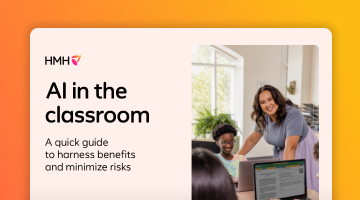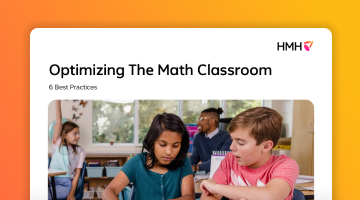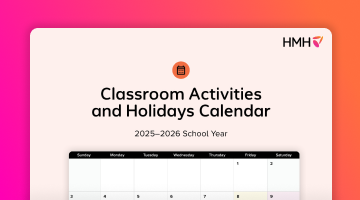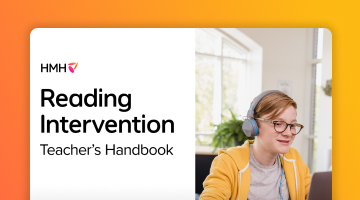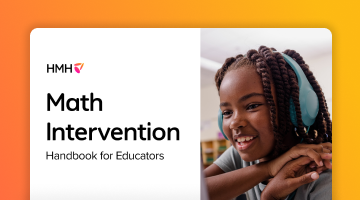
In construction, scaffolding refers to a temporary structure used to support workers and materials during the construction or repair of a building. You can think of scaffolding in education in a similar way—it’s a framework that supports students as they build understanding and skills, until they're ready to work independently.
Effective scaffolding requires knowing when to step in, how to guide, and—just as importantly—when to step back. Keep reading for instructional scaffolding examples and strategies that can be applied across subjects and grade levels.
What is scaffolding in education?
Scaffolding is a teaching approach that provides students with the guidance, tools, and structure they need at the beginning of the learning process. As students’ understanding grows, teachers can gradually remove supports, allowing students to take on more responsibility and work independently. Just like in construction, once the structure—in this case, the student’s understanding—is strong enough to stand on its own, the scaffolding can be taken away.
6 essential scaffolding strategies
Teachers can use a variety of strategies to provide students the support they need when learning a new skill or concept. Each scaffolding teaching strategy is designed to meet students where they are and provide the right level of support to help them progress toward independent mastery. Here are six scaffolding strategies that work:
Strategy 1: "I Do, We Do, You Do"
This scaffolding teaching strategy demonstrates a gradual shift in responsibility from teacher to student in three parts:
- I Do: The teacher models the skill or concept, demonstrating how to approach the task while thinking aloud to show their reasoning.
- We Do: The teacher and students work together to solve the problem with guided practice or active engagement. Students may work in groups or with partners, while the teacher offers support and feedback.
- You Do: Students apply what they learned independently, showing they can complete the task on their own.
Strategy 2: Activate prior knowledge
Just like a builder checks the foundation before adding new structures, teachers can tap into students’ background knowledge before introducing new concepts. Teachers can assess student understanding through discussions, quick writes, or completing a KWL chart. By checking what students already know, teachers can identify misconceptions, fill in gaps, and tailor instruction to bridge familiar ideas with new concepts.

Strategy 3: Chunk the learning
One effective scaffolding strategy is breaking tasks into smaller, manageable steps or “chunking” content into logical sections. By simplifying complex tasks into sequential steps, teachers make it easier for students to follow the process and build understanding gradually. This approach prevents students from feeling overwhelmed and allows them to focus on one part of the learning at a time. Chunking content also supports memory and comprehension as students are more likely to retain information when it’s presented in smaller, meaningful pieces.
Strategy 4: Model your thinking
Modeling how to approach a task or think through a problem gives students a clear example to follow when they're ready to work independently. In math, teachers may model how to solve a word problem with division or how to chart a graph. In ELA, teachers may model how to find credible sources or how to create an outline for an essay. As teachers walk students through a process step by step, they can share their thinking aloud, helping students understand not just the “what,” but also the “how” and “why” behind the task.
Strategy 5: Check for understanding
Checking for understanding is a useful strategy that allows teachers to gauge whether students are grasping key concepts before moving on. This ongoing process can take many forms—such as formative assessments, asking questions, prompting discussions, using exit tickets, or observing student work in real time. By actively monitoring comprehension, teachers can identify areas where students need additional support and adjust instruction accordingly. Use this exit ticket after a lesson as a quick check of engagement and understanding.

Strategy 6: Ask strategic questions
Asking strategic questions is a scaffolding strategy that guides students’ thinking and deepens their understanding. If teachers can anticipate potential misconceptions ahead of time, they can prepare thoughtful, targeted questions that address gaps in knowledge or incorrect assumptions. These questions prompt students to reflect, justify their reasoning, and make connections between ideas. For example, teachers using this strategy for scaffolding in math may ask, “What do you notice about numbers in this equation?” or “Can you explain your thinking in a different way?” These questions not only guide students toward deeper understanding but also encourage math talk.
Examples of scaffolding in the classroom
The following examples of scaffolding in education offer practical ways for teachers to provide support while also encouraging students to increasingly take ownership of their learning:
- Think-aloud: In a think-aloud, teachers explain their thought process while solving a problem or reading a text. For example, during small-group reading instruction, a teacher could take a break from reading and ask, “I wonder why the author used this language?” The class can then discuss the author’s purpose.
- Graphic organizers: Using graphic organizers or visual aids helps students organize information, making complex content more manageable. Some examples of graphic organizers are charts, Venn diagrams, timelines, and concept maps.
Sentence starters and frames: Sentence frames are incomplete sentences that provide students with a structured starting point for expressing their ideas and explaining their reasoning. A sentence frame for ELA may look like this:
“The main problem in the story is ______ and is resolved when ______.”
In math, a teacher may ask, “What steps did you take?” The student can respond using this math sentence frame, “First, I ______. Next, I______. Lastly, I _______.”
- Pre-teach vocabulary: Teachers can introduce key terms before a lesson, giving students the language they need to better understand complex texts or concepts. This is an especially useful example of scaffolding for multilingual learners, who may need additional support. Pre-teaching vocabulary includes defining words, using them in context, and pairing them with visuals. The Frayer square chart can be a useful tool when pre-teaching vocabulary.

- Anchor charts: Anchor charts are visual teaching tools used in classrooms to display important concepts, strategies, or information that students can refer to throughout a lesson or unit. Teachers can create the anchor charts with students, guiding them through the information and addressing any questions along the way.
- Real-life examples: Using real-life examples in the classroom bridges the gap between theory and practice, helping students understand how their learning applies to the world around them. Consider writing assignments that relate to students' lives. For example, they might write persuasive essays arguing that recess should be longer or that school should start later. This way, they can use research along with examples from their own experience. This persuasion map will help them get started. Check out this blog for more examples of scaffolding writing instruction that will boost the skills needed for students to become better writers.

Building a strong foundation for future learning
By incorporating effective strategies for scaffolding, educators create structured learning environments that support student growth and independence. These strategies can bridge the gap between current understanding and new concepts. As students gain confidence and mastery, scaffolding can gradually be removed, leaving behind a solid foundation that supports their future learning and growth.
***
HMH Coachly equips teachers of all experience levels with year-round support to meet their goals.
Related Reading

Teachers are all too familiar with the challenge of adapting to the needs of every student in the classroom. Knowing when and how to use differentiation vs. scaffolding in instruction can help.

This article explains why to provide scaffolding "just in time," i.e., when students demonstrate the need, not "just in case."

Here we provide differentiated instruction strategies and examples that teachers can use to ensure students have choices for the way that they learn new information, practice skills, and demonstrate understanding.
Be the first to read the latest from Shaped.

